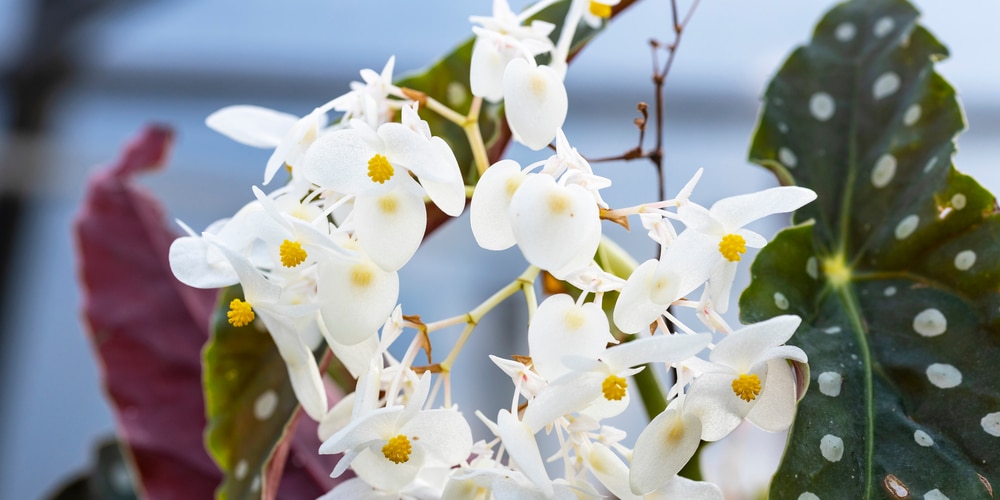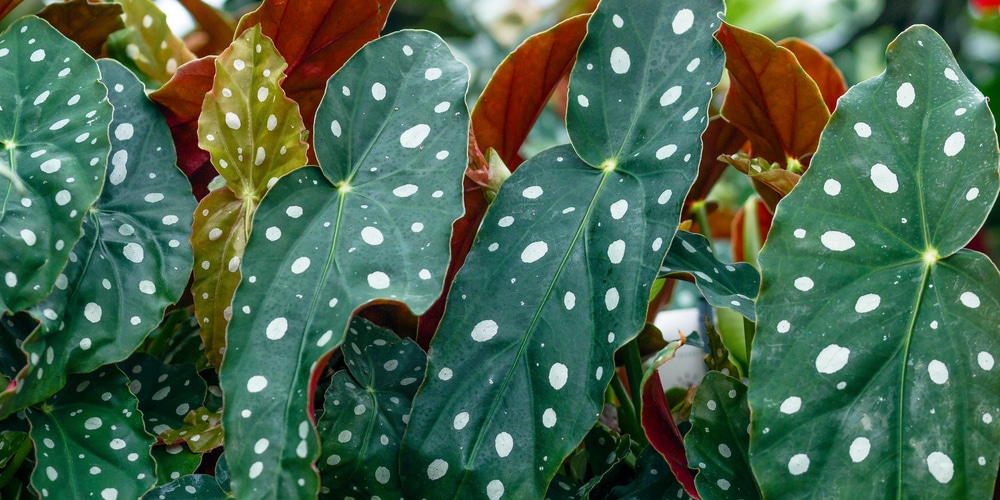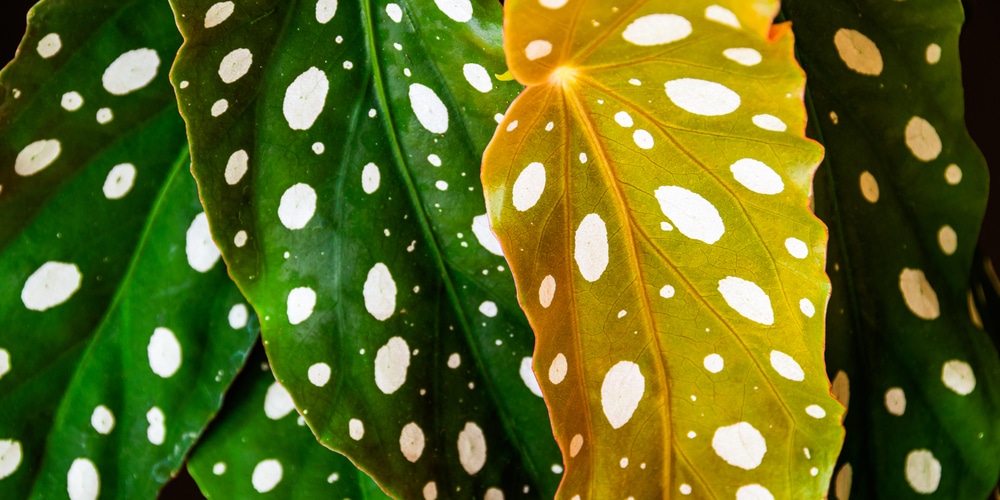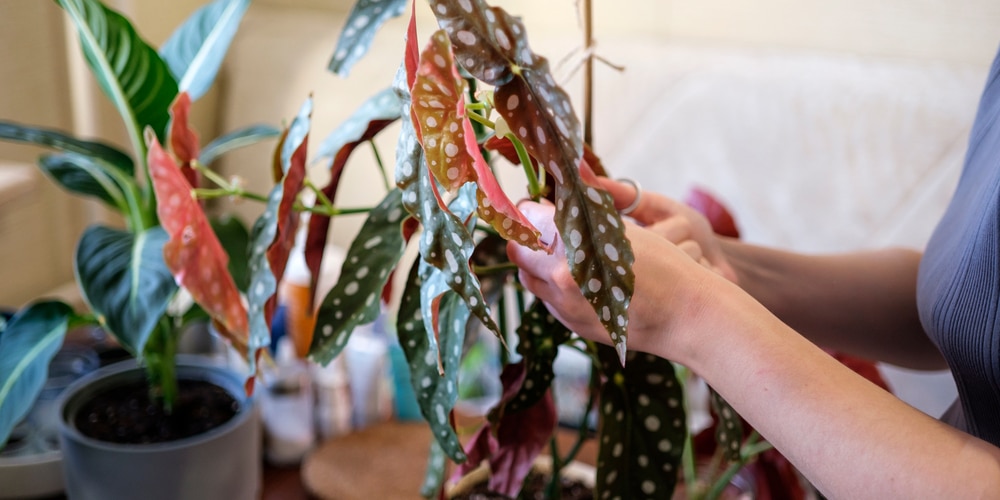Begonias are among the most versatile flowering plants available to home gardeners. They are sturdy, colorful, and easy to grow in both bright sun and shade. With its spotted leaves with red undersides, Begonia maculata is a popular ornamental plant.
The leaves are said to look like angel wings, and these plants are very unique and eye-catching. They are commonly referred to as the Polk Dot Begonia. Let’s look at how to grow and care for a Begonia maculate.
What is a Begonia Maculata?

The Begonia Maculata or polka dot Begonia is part of a genus of perennial flowering plants in the family Begoniaceae. The genus contains more than 1,800 different plant species and many hybrids and cultivars. These plants are native to tropical and subtropical regions of Mexico, Asia, South Africa, and Central America. They like a warm, humid environment and can be grown outdoors in USDA zones 10 b to 11.
The Begonia Maculata produces small flowers in the spring, which are either white or a light pink color. They have a yellow middle and look beautiful. Most polka dot begonias will grow to a height of 4 to 5 feet or smaller when kept indoors. They may get slightly bigger if grown outside in perfect conditions.
It’s worth noting that the leaves and stems of the plant contain soluble calcium oxalates, which are toxic to humans, cats, dogs, and horses if consumed. The plants can also cause skin irritation in some people. It’s best to keep these plants out of the reach of pets and small children.
How to care for begonia maculate

Begonia plants need to be cared for properly to ensure the longevity of their life. Begonia maculata is a tropical plant well adapted to the warm, humid climate. It will do best when planted in bright sunlight but can adapt to partial shade conditions as well.
Begonias prefer well-drained, humus-rich soil with enough nitrogen to promote healthy foliage growth. The begonia thrives in moist climates but not standing water. Here are some tips to help you grow a beautiful begonia maculate that’s healthy and thriving.
Soil
Adding mulch on top of the soil around your begonias will help protect them from the cold winter weather, keep moisture in and add beneficial nutrients to the soil. Begonia Maculate prefers soil that’s well-draining and loamy. You can
add some sand and clay to the ground to create the right earth type for begonia growth. These plants prefer a soil pH that’s slightly acidic and is between 5.5 and 6.2.
Sunlight Needs
The sun’s rays provide the energy your begonias need to grow and develop. The begonia maculate does best in bright indirect sunlight with some shade. Too much sunlight can cause the leaves to discolor, and if you leave your plant in the full sun for too long, the leaves will become scorched.
Watering Requirements
Watering your begonias will depend on the growing conditions. Too much water or too little can harm your plants’ growth and development. The Begonia Maculate is very sensitive and can easily suffer from root rot if overwatered. Aim to keep the soil damp, but be careful it doesn’t become waterlogged. You can check the earth by touching it with your finger to check whether your plant needs to be watered.
Fertilization
To keep them healthy, fertilize your begonias once a month with a general-purpose fertilizer. Use a balanced fertilizer such as 10-10-10 or 20-20-20 at half strength every time you water your begonias should be sufficient. Too much fertilizer can burn their roots and kill them prematurely.
Pruning
Pruning should be done in early spring to encourage new growth and healthier foliage. Take care not to damage the plant’s roots when pruning as they are very fragile. Growth can be encouraged by pinching back flowers as they appear so that energy is directed into leaf production instead of flower formation.
You can also deadheading spent blooms and removing leggy growth by pinching tips above the nearest leaf node.
Mulching
Mulching can be beneficial to outdoor plants as it will keep weeds away and also adds protection against temperature drop. Plus, it keeps moisture in the soil for longer periods of time during summer.
Temperature and Winter protection

Begonia Maculate can be grown indoors or outside in USDA zones 10 b to 11 and thrives in temperatures between 67 and 70F. In slightly colder climates, you can move your plant outside onto a patio for the summer. Be sure to bring your plant inside in the fall so that the cold weather does not damage it.
Don’t leave your plant outside if temperatures are likely to fall to below 67F or if frost is expected. When winter comes, protect all tender plants from frost damage by covering them with garden fabric or similar materials. Also, be sure to move them to a sheltered location that does not get too much direct sunlight.
How to Propagate a Begonia Maculata

There are two ways to propagate a polka dot begonia; either through stem cuttings or by growing a new plant from seed. Let’s look at both these options in more detail.
Growing Begonia Maculata from Stem Cuttings
Cuttings are ideally taken from new growth near the base of the plant. Only take cuttings from plants that are mature and healthy. It’s best to choose a healthy-looking stem with at least one or two leaf nodes before taking it for propagation.
1. Place the cuttings in a plastic bag and keep them in the shade until you are ready to place them.
2. Fill small pots with moist, well-drained potting soil. Dip each cutting in rooting hormone powder before planting them an inch deep in the center of the pot.
3. Water thoroughly but gently so as not to disturb the soil or cuttings.
Growing Begonia Maculata from Seeds
Begonias grown from seed take longer to develop, but if you’re patient, you can grow a beautiful plant from seed. Start begonia seeds indoors in the early spring and plant the seeds
one-quarter of an inch deep in sterile, well-drained potting soil. Place your seed tray on a window sill in bright indirect sunlight. As soon as the first true leaves appear, transplant your seedlings into larger pots or outdoors in a sunny location.
Conclusion
Begonia Maculata is one of the easiest flowering plants to grow, which is why they are so widely available. All you need to do is follow basic care instructions for your specific species, and you will enjoy their beauty inside or out no matter what time of year it is!
Related: Never Never Plant Growth and Care